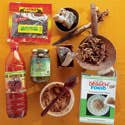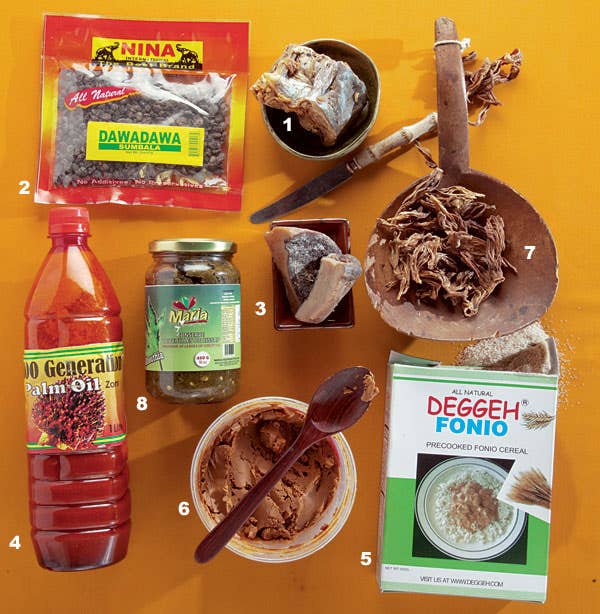
Senegalese Shopping List

1. Thick chunks of salty, pungent gejj, made by fermenting and drying various kinds of white-fleshed fish, are added whole or crumbled into sauces and stews.
2. Netetou, which also goes by the names dawadawa and sumbala, is made from African locust beans, which are pulverized, fermented, and dried to make a funky seasoning similar to the fermented black beans used in Chinese cooking.
3. The flesh of sea snails fermented and dried makes an ingredient called yeet, which imparts a musky flavor to soups and stews, including Senegal's national dish, thieboudienne. All of the above are available at African markets in the U.S., but even in Senegal, cooks often substitute Southeast Asian-style fish sauce, which imparts a similar brininess.
4. Vividly red palm oil, obtained by crushing the fruit of the oil palm, is lower in saturated fat than the palm kernel oil obtained from the seed of the same fruit. Semi-solid at room temperature, palm oil has a pleasant, mild, nutty taste. It's used as a frying medium and also to bring flavor, color, and richness to stews and other dishes.
5. Tiny seeds of fonio, a species of millet considered a "super-grain" thanks to its high concentration of nutritious amino acids, are steamed and served in many parts of West Africa as a staple side dish, similar to rice or couscous.
6. Natural peanut butter is what gives the luscious stew mafe its rich flavor and silky texture; you can also make your own by grinding roasted peanuts. Just be sure to steer clear of commercial peanut butters containing sugar and stabilizers that will alter the flavor of the dish.
7. The dried petals of red and white hibiscus, called bisaap in Senegal, bring a tart flavor to many dishes and drinks. The white flowers, known as bisaap blanc, have a milder tartness than the red ones do.
8. The leaves of hibiscus are also used in cooking. They are simmered with chiles, salt, and okra until they break down into a thick paste called khouthia, a piquant condiment that's served alongside grilled chicken and fish, and cuts the richness of mafe and other unctuous dishes.
Keep Reading
Continue to Next Story










